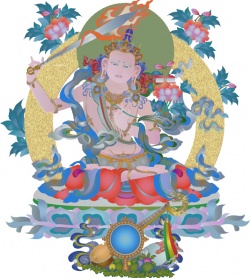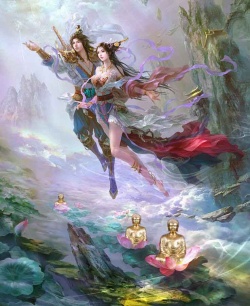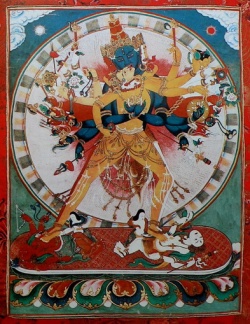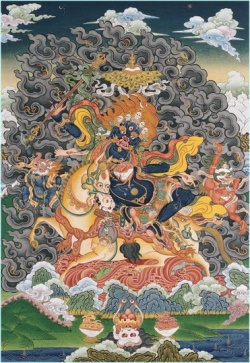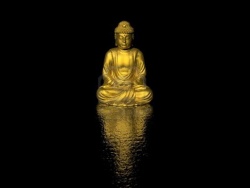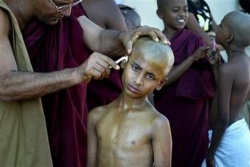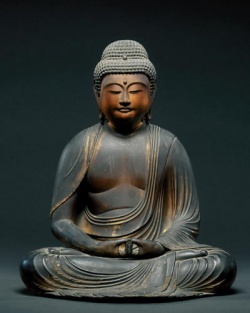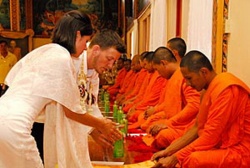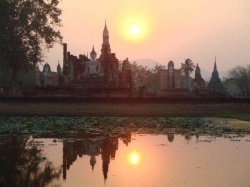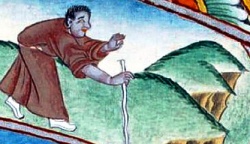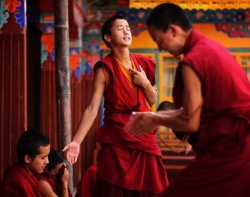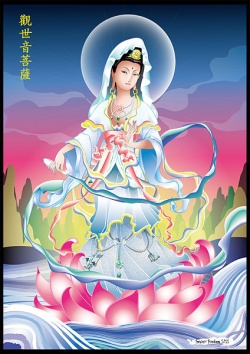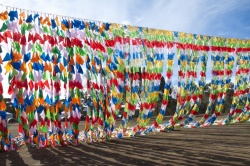Difference between revisions of "Jang Ter"
| Line 1: | Line 1: | ||
| − | + | <nomobile>{{DisplayImages|1397|3035|3870|1521|47|491|917|1129|2479|3743|3769|3572|4240|2368|419|945|337|3509|379|3158}}</nomobile> | |
Revision as of 12:57, 16 December 2015
Brief Introduction and History
- A series of treasures revealed by Rigdzin Godem, one of the Three Great Tertons. This tradition contains the famed Gongpa Zangthal cycle. EPK
The Beginning of The Northern Treasures
In the 8th century, the influence of Kingdom of Tibet extended from what is now China and Iran to the Ganges River in India. Tibet was the military power of central Asia. Buddhist teachers had been coming to Tibet for some time but their influence had been limited. According to tradition, the Khenpo Shantarakshita had been teaching there for some time but was unable to establish anything permanently.
He advised the king to invite Padmasambhava, an adept in the branch of Buddhism known as Mantrayana or Tantrayana. The work of Padmasambhava, Shantarakshita and the King Trisong Detsen (790-858 CE) can easily be found elsewhere. Together they established Buddhism in Tibet setting the stage for the next twelve hundred years of Tibetan culture and life.
Before leaving, Padmasambhava was requested by his Nepali consort Shakya Devi to leave teachings for future generations. With the help of Lady Yeshe Tsogyal, Padmasambhava hid teachings in various places. Known as treasures (Tib. gter), they were intended to inspire future generations by providing both methods of meditation practice which are fresh and also objects of support to inspire and deepen practice.
Treasures as objects can include ritual implements, statues, paintings. Others are teachings found written on scrolls of yellow parchment written in a script which can only be comprehended by the one intended by Padmasambhava to receive it.
The revealers of these treasures are subsequent rebirths of the disciples of Padmasambhava during his time in Tibet. There are other teachings which might be treasures of other masters, but among the Buddhist schools in Tibet, the treasure traditions are almost exclusively attributed to Padmasambhava's intention.
Among the many great disciples of Padmasambhava who later appeared in the Northern Treasure lineage are: Nanam Dorje Dudjom, Namkhai Nyingpo, Nyak Jnanakumara, Gyalwa Choyang, and Princess Pemasal.
The Jangter of Rigdzin Godem
The Jangter, or Northern Treasure, was discovered in the year 1366 by the Great Awareness-Holder Rigdzin Godem, in the cave of Zangzang Lhadrak. Rigdzin Godem was born in 1337, in a family of High Phurba Pracitioners. He was renowned both as a Scholar and as an Accomplished Meditator. In accordance with a prophecy, when he was young five protuberances looking like Vulture feathers grew on his Head, so he became famous as Rigdzin Godem, the Awareness-Holder with Vulture feathers on his head.
In the Cave of Zangzang Lhadrak, Rigdzin Godem found a great Treasure Chest containing five Treasure Chambers disposed like a Mandala. Inside were found many Texts covering a great variety of topics: Prayers, Tantric Sadhanas, Rituals, Instructions for High Dzogchen meditation, and so on. He wrote them down in a suitable form, and transmitted them to worthy students. Quickly, the Teachings of the Northern Treasures spread to all the regions of Tibet.
Later, in his third Incarnation, Rigdzin Godem established the great Monastery of Dorje Drak in Central Tibet, which quickly became renowned as one of the most important centers of Study, Practice and Spiritual Activity for all the Nyingma Old Translation School. This Dorje Drak tradition of the Northern Treasures has been transmitted up to the present day without ever being interrupted; H.H Taklung Tsetrul Rinpoche is nowadays his Most Revered Lineage Holder.
Some words about the Northern Treasures
In the Great Terma Tradition of the Nyingma School, a great number of Treasures have been concealed by Guru Rinpoche and Yeshe Tsogyel, for the benefit of future generations. Accordingly, in the course of time, many Termas have been discovered by different Treasure-Finders, or Tertons. Among these, because of their own Spiritual Attainments, or the fact that they were the Incarnations of Great Masters, some Tertons have been considered as specially important, and their Termas have been said to be very powerful Transmissions, endowed with a superior Blessing Power. In this way, the Tradition mentions the Five Terton-Kings, and so on. More specially, there are the Three Supreme Emanations, who are full Manifestations of the Body, Speech and Mind of Guru Rinpoche. The Body emanation is Nyang Rel Nyima Od Ser, and the Speech emanation is Guru Chowang; the Great Awareness-Holder Rigdzin Godem, discoverer of the Byangter, is the Emanation of the Mind, the highest of the three. Because of that, his Northern Treasures Terma is endowed with a very exceptional Spiritual Power, and can be the source of extraordinary Blessings for the Practitioner. It is sometimes said to be the supreme Transmission among the Old Termas, the King of the Old Termas.
Moreover, the Byangter of Rigdzin Godem has many special features, that make it a truly extraordinary Transmission; it would be difficult to explain them in detail, and some of them can be understood only in Meditation. We can just mention a few points. For instance, in the Yidam or Tutelary Deities section, can be found two very uncommon Transmissions: The Self -Appearing and Self-Arising Mandala of the Eight Herukas (Ka Gyed Rang Jung Rang Char), the most extensive and most profound of all the Eight Herukas Sadhanas, featuring all the nine mandalas of the Ka Gyed in fully complete form, with all the secondary deities, and the Black Deity Byangter Phurba, a very extensive Transmission of the Great Sadhana of Vajra Kilaya, including many additional Texts allowing Practitioners to perform the various Activities of the Yidam in a specially powerful way. It is widely recognized as the best transmission of Vajra Kilaya in all the Nyingma Tradition. In the Protectors section, the main male Protector Deity is not the two-armed Gonpo Maning, like in most other Termas, but the Great Supreme Yeshe Gonpo Chadrukpa, with three faces and six arms, the Highest and Most Powerful of all the Mahakala Deities. There is also the great Rahula Sadhana, the Outer, Inner and Secret Mahadeva, and so on. Because of all these special Yidams and Protectors Transmissions, it has been said that, regarding the many different types of Magical and Spiritual Activities, whether Peaceful or Wrathful, the Byangter of Rigdzin Godem is truly unsurpassed among all the Termas of Tibet.
But the most remarkable feature of the Byangter Transmission, the most famous and the most highly praised, is its Dzogchen Section, the great collection of High Meditation Practices known as The Transference into the Mind of Samantha Bhadra, (Kuntu Zangpo Gong Pa Zhang Thel), a complete system of Dzogchen Teachings covering all the aspects of the way of the Great Perfection, from the first introductory levels to the highest Secret Instructions of Thod Gel. Praised by many Masters for its profundity and its clarity, it has been the source of the highest Realisations for many Practitioners. It is in fact considered as one of the three Supreme Transmissions of Dzogchen, together with the Nying-Thik Yab Shi of Longchenpa and the Short Instructions of Terdak Lingpa. It has been said that the bare fact of receiving the Empowerment of Gong Pa Zhang Thal closes for ever the door of the Lower states of Existence, and can be the source of innumerable Spiritual Benefits.
So, considering that there are still many other special features that we cannot mention here, it is easy to understand why the Jangter of Rigdzin Godem has always been considered as a very precious transmission, and one of the most important of the Old Termas. -Until recently, the full Transmission of the Northern Treasures was rarely given, and was very difficult to obtain. During the last few years, due to the Compassionate Activity of H.H Taklung Tsetrul Rinpoche, and of H.H Chhimed Rigdzin Rinpoche, founder of the Siliguri Khordong Monastery, it has been possible for more practitioners to receive the Empowerments of this Great Tradition, and Byangter practice has begun to develop more and more both in Eastern and Western countries. So we can hope that, as more people become interested, and as Scholarly Studies, Research and Translations begin to develop, the number of Byangter practitioners will continually increase, and gradually the Blessings of this Great Spiritual Lineage will be able to spread everywhere.
- Source:Chhimed Rigdzin Society
These prayers and practices have remained popular throughout Tibet to this day. Currently available in several English translations, the practices based on each chapter were later revealed by Ngari Panchen Pema Wangyal as treasures. Jamgon Kongtrul also wrote a set of visualizations according to the Mindrolling tradition. In the year 1366 C.E. (the Fire Horse year of the Tibetan calendar), on April 19th (eighth day of the snake month) Rigdzin Godem brought out the key to the main body of the Northern Treasures from the top of mount Tratzang.
On June 14th (fourth day of the sheep month), he brought out the treasures themselves. Waiting with his disciples, the first rays of sunlight struck inside a cave on a rock shaped like a crossed vajra. Under this, he found a rock door which opened to the chamber containing a square blue chest with five compartments. Each compartment held teachings which over time, he transcribed, practiced and in due time transmitted. Since each section contained teachings on one hundred topics, there were five hundred in all along with various sacred objects.
Just as a minister serves the needs of the king and kingdom, these teachings are known as serving the needs of people throughout the land . Later in life, Rigdzin Godem traveled to Sikkim where he taught Dharma, opening several monasteries. There in the year 1408, he dissolved into the Dharmakaya at the age of seventy-two at Zilnon Lhakang. Among his disciples were those known as the eight close sons, the eight consorts, and the three close disciples.
His son Namgyel Gompo, his student Gompo Dorje, and his consort were his main students. From these, flowed out three streams of teachings and practice until the time of the fourth Rigdzin Godem tulku, Pema Trinley who united these into one stream of practice.
The lineage carried on by Changchub Ling is the Northern Treasures tradition. His Holiness Dilgo Khyentse used to say that the Northern Treasures is like a minister since it contains teachings from the more esoteric to the mundane. The minister has the capacity to reach everyone, to relate to people at all levels; he has to be able to relate to people at the highest level, such as a king, and he also has to be able to relate to ordinary people. The Northern Treasures was one of the main practices of King Trisong Detsen. As Guru Padmasambhava was about to depart for the Copper-Coloured Mountain and was residing at the Gungtang in Mangyul, he miraculously manifested and concealed a treasure near a place called Zang Zang Lhadrak. Later the Northern Treasures was revealed by the great Rigdzin Godemchen who established this teaching, which later became the main practice of the great 5th Dalai Lama.
The main seat of the Northern Treasures teaching was the great monastery of Thubten Dorje Drak Monastery, one of the six great Nyingma monasteries. There's a quote from Guru Rinpoche that says, 'When this excellent teaching degenerates, then Tibet in general will degenerate.' All the different teachers have said that the Northern Treasures was particularly created as a means to preserve the happiness and well-being of the people of Tibet. Since the Northern Treasures has been established and practised in Tibet, almost all Nyingma teachers have practised this tradition. For example, The Prayer in Seven Chapters, as well as The Prayer of Samantabhadra, belong to the Northern Treasures.
Before Dordrak Rigdzin Chenpo Pema Trinley united the three main practice traditions, the Changling Tulkus were head of the branch which originated from Rigdzin Godem's wife.
Historical Lineage Masters
- Nanam Dorje Dudjom
- Rigdzin Godem
- Tulku Zangpo Drakpa
- Ngari Panchen Pema Wangyal
- Dordrak Rigdzin Chenpo Lekden Dudjom Dorje
- Jangdak Tashi Tobgyal
- Ngagchang Shakya Zangpo
- Thangtong Gyalpo
- Pema Tsewang Gyalpo (Tenyi Lingpa)
- Changchup Lingpa
- Dordrak Rigdzin Chenpo Ngagi Wangpo
- Yolmo Tulku Rigdzin Tendzin Norbu
- Zurchen Choying Rangdrol
- Ngawang Lobsang Gyatso
- Ngari Terton Pema Garwang Dorje
- Yolmo Tulku Rigdzin Wangyal Dorje
- Dordrak Rigdzin Chenpo Pema Trinley
Present Root Masters
Jangter Root Termas
- byang gter bka' rgyad
- byang gter dgongs pa zang thal
- byang gter khyung nag
- byang gter sgrub skor rnam gsum
- byang gter thugs sgrub
- byang gter rig 'dzin gdung sgrub
Jangter Root Sadhanas
- las byang gter gzhung
- longs sku 'chi med 'od snang
- rig 'dzin gdung sgrub kyi chos skor
- thugs sgrub drag po rtsal gyi chos skor
- gshin rje'i gshed char ka nag po'i sgrub skor
Jangter Literature
- In Tibetan
- Le'u Dunma
- Commentary on Kun bZang dGongs Pa Zang Thal – Boundless Vision. A Byangter Manual on Dzogchen Training. by Tulku Tsultrim Zangpo (Tulku Tsurlu, Tshul Khrims bZang Po) ([1])
- Le'u Dunma
- In English
- In Tibetan
- Guru Rinpoche His Life and Times
- A Treasure Trove of Blessing and Protection
- Prayer of Seven Chapters: gsol 'debs le'u bdun ma ([2])
- Commentary on the Five Nails by Tulku Tsultrim Zangpo (Tulku Tsurlu, Tshul Khrims bZang Po) ([3])
- Prayer of Seven Chapters: gsol 'debs le'u bdun ma ([2])
- Illuminating Sunshine: Buddhist funeral rituals of Avalokiteśvara by Martin Boord (Rig-’dzin rdo-rje) ([4])
- A Roll Of Thunder From The Void, Vajrakila texts of the Northern Treasures Tradition, Volume Two by Martin Boord (Rig-’dzin rdo-rje) ([5])
- Illuminating Sunshine: Buddhist funeral rituals of Avalokiteśvara by Martin Boord (Rig-’dzin rdo-rje) ([4])
Internal Links
External Links
- http://northerntreasures.org/ northerntreasures.org
- http://www.khordong.de/Engl/Rinpoche/Temp$$$.html THE GTER-STON RIG-’DZIN RGOD-LDEM an account of the origin and development of the Byang-gter or Northern Treasures tradition
